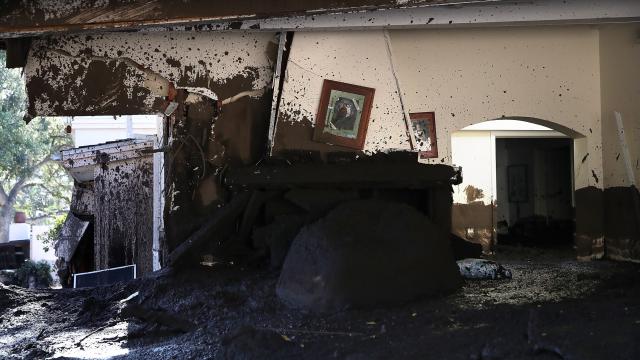Winter is coming to the U.S., and in Western states it’s not just bringing snow, skiing, and hot toddies. Some Left Coasters are bracing for terrifying mudslides that could carry away or crush buildings, vehicles, and people.
Amazingly, you can increase your chances of surviving a landslide with a few simple actions. According to a recent University of Washington study, people usually survive landslides less than 0.9 meters deep and rarely survive ones over 5.9 metres. In between 1 and 6 metres, though, survival seemed to depend on previous planning and quick thinking. Just dashing upstairs, for example, can increase your chance of surviving 12 times over.
Know whether you’re in landslide territory
Last summer’s record-breaking U.S. wildfires burned 33,000 square kilometres, an area equivalent to three Yellowstone National Parks and two Yosemites. Where fires burned hottest, they incinerated trees and other vegetation right down to the roots, leaving piles of ash and damaged soil. Once heavy rains arrive, those burned soils can turn to fast-moving, exceptionally dangerous landslides. The U.S. Geological Survey published a handy map of landslide risk, showing which mountainsides are most likely to give way.
If you’re downhill from a high risk area, be prepared. Emergency services may warn you to evacuate ahead of a big storm, and you should. But what if, for whatever reason, you haven’t evacuated? There you are in bed; you hear branches cracking and a rumbling like a freight train. Don’t just lie there! Move.
What to do before the landslide
Learn about landslides; talk to people who have experienced them; and make plans.
Move your bedroom upstairs and to the downhill side of the house. If a mudslide speeds downhill towards your house in the middle of the night, debris will slam through windows and doors on the uphill side. At minimum, move beds away from exterior walls.
Identify and prepare a small, interior, unfurnished room: Closets, bathrooms, and other small spaces are less likely to collapse. Remove furniture that could crush you. One landslide survivor dove into a closet and survived for nearly 5 hours under 9 meters of debris.
During the landslide
Be alert to the sounds a landslide makes — a rumbling or snapping of branches and trees. You might have 40 to 60 seconds before it arrives.
Escape up! Whether you run to a second floor, the roof, or even just hop on a counter in the kitchen, getting up high dramatically reduces the risk of death. Those on an upper floor, attic, or roof survive 95% of the time. And, like we said, getting upstairs increases survival 12 times.
Take cover in that cupboard.
Because doors usually open inward, a landslide coming downhill will push open doors and rapidly fill a building with mud and boulders, suffocating people inside or bursting the building. If there’s time, open downhill doors or windows to allow the mud to flow back out.
Meanwhile, here’s what not to do:
- Don’t go outside.
- Don’t open a door out of curiosity.
- Don’t take cover by a piano or other large piece of furniture; it could crush or strike with deadly force.
After it’s over
Once the landslide has stopped, you may be trapped — in a pile of mud, beneath rubble, in a small room, or on an upper floor. In two major landslides in the University of Washington study, almost half of those caught in the landslide were killed, while 28% escaped on their own and 20% were rescued. You want to be one who makes it. But, of those who were rescued, only 11% were found by first responders. At best, first responders may take a while to arrive; at worst, blocked roads may prevent emergency vehicles from arriving at all.
Your neighbours are your best bet. Of the people who were rescued, 77% were first found by neighbours, usually in just a few minutes. Timing is critical. If you are trapped, you may have severe injuries and you may be at risk of suffocating from pressure on your chest or limited air in a small space. Wave objects and make noise to attract attention so they’ll find you. Shout, whistle, or bang on debris. Neighbours will do what they can to help, but you may have to wait until first responders can extract you. Don’t give up.
Jennie is a freelance science writer. She has been writing about science and medicine for nearly four decades, including several books. In her youth, she rebuilt a 1973 Norton Commando motorcycle.

Leave a Reply
You must be logged in to post a comment.